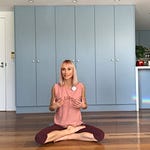Today I speak to something sacred — something we often avoid, yet something that - perhaps - holds the key to living more freely, more honestly, and with more presence.
Death.
And as morbid as this might sound, I don’t mean it to.
I don’t mean to frighten and instil fear but rather befriend.
I also want to honour friends who have recently lost loved ones - the grief and depth of sadness that are still being felt. This post is not to belittle your experience nor reduce it - no one gets to tell you how long and how deep.
In yoga, the pose of Savasana — our final posture — is often called the "corpse pose."
‘Sava’ in Sanskrit literally translates to ‘corpse’
It’s where we lay everything down: the breath, the doing, the striving, the stories.
It’s a rehearsal. A reminder. A holy pause.
When we consciously contemplate death, we don’t become morbid - we become more awake; more attuned to what actually matters. More alive. We stop waiting for the “perfect” moment and start showing up for the real one. This one right now.
I’ve shared this quote by Pema Chora 100 times in class but I have to share it because it rings so true to me:
“To be fully alive, fully human, and completely awake is to be continually thrown out of the nest. To live fully is to be always in no-man's-land, to experience each moment as completely new and fresh. To live is to be willing to die over and over again. ”
We get the opportunity each day to let go of what’s been to make space for what wants to unfold. We let die what we think we know or what we think should happen to make space for the great mystery to come through.
In class this week, I shared this reflection:
“If you die before you die, you won’t die when you die.”
These words — from mystic traditions — remind us that the practice of letting go isn’t a one-time act
It’s daily.
Breath by breath.
Choice by choice.
To soften.
To surrender.
To release what no longer serves.
When we stop resisting death, we stop resisting life.
We become present.
We forgive faster.
We speak truth sooner.
We love softer.
I guess what inspired the heavy contemplations on death was that I went to a wake last week. I was far enough emotionally removed that I could appreciate the beauty in grief and the beauty in celebrating someone’s life. And depending on your belief system you may even celebrate the idea that this person’s soul lives on and who knows where it will show up next.
So maybe the most spiritual act we can do today is to ask ourselves:
If I knew it would all end soon… how would I live now?
I’ve been sharing some of these reflections inside my course, Restoring Rhythm. We’re exploring how most things — outside of us and within us — move in cycles.
Your breath.
Your energy.
Your emotions.
Your creativity.
Your hormones
The seasons.
The moon.
The tides.
There is a rhythm that governs life — and death is part of that rhythm.
I can relate to ‘death’ in where I’m right now too in my career. Having sold Flow and although still teaching I’m spending a lot of my time in a liminal space trying not to just ‘fill it’. This death of a cycle of my life was initially frightening. Now I’m learning to respect it. And not miss it - not let it just pass by without having fully honoured it.
This past weekend on my way to Saturday morning classes I stopped at some traffic lights and contemplating the falling leaves on a tree I’ve driven past hundreds of times before.
There is was. Steady. Grounded. Rooted. It was still — standing exactly where it always has —
but its branches were bare.
Empty.
Stripped.
This, too, is rhythm.
This shedding.
This surrender.
This quiet fall into rest.
The tree doesn’t fight its own winter.
It doesn’t cling to last season’s leaves.
It trusts that spring will come.
That something new will rise — in time.
How often do we resist this part of the cycle in ourselves?
We rush.
We cling.
We push forward when life is asking us to slow down…
To let go…
To allow something to die so something else can bloom.
That’s what Restoring Rhythm is all about — remembering how to live in alignment with the natural cycles of life.
To honour the inhale and the exhale.
The blooming and the falling away.
The becoming and the undoing.
So wherever this finds you —
maybe in your own winter,
maybe in your own letting go —
know this:
You are not broken.
You are in rhythm.
And remember, death isn’t just the end of a life.
It’s also the end of a season, a role, a relationship, a pattern, a story.
Each time we allow something to die, we create space for something more truth to rise.
Thank you for being here and listening — in this breath, this body, this moment.
Until next time,
may you live fully,
love softer,
and rest (and practice savasana) often.
KK









